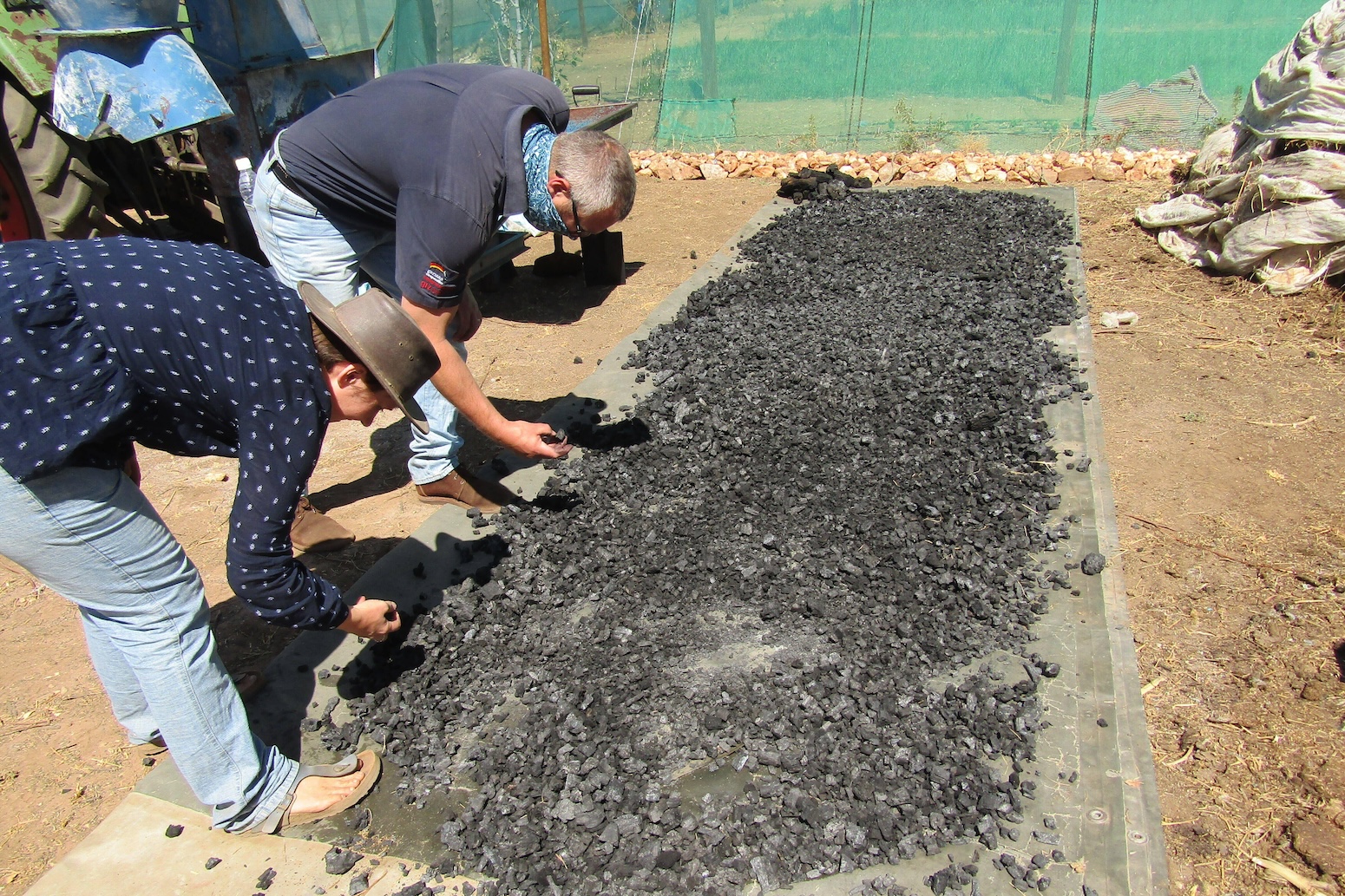From tree-planting to spreading silicate rock mud over land, the methods for “carbon dioxide eradicating” (CDR) differ in technique, impacts, readiness and worth.
The second “State of CDR” report, led by a collaboration of scientific institutions from Europe and the US, targets to summarise the place the world in the intervening time stands within the case of eradicating CO2 from the air.
The report covers each half from what variety of tonnes are in the intervening time being “drawn down” from the ambiance and saved by way of to the occasion of research grants, insurance coverage insurance policies and media safety.
Scientists are clear that worldwide areas ought to cut back their emissions as fast as doable to attain native climate aims.
Nonetheless the utilization of CDR to counterbalance emissions that are troublesome to take away completely, akin to methane from rice farming, could be “unavoidable” if the world is to attain net-zero, in accordance with the Intergovernmental Panel on Native climate Change (IPCC).
Nonetheless, some environmental groups have issues that extraordinarily polluting companies and worldwide areas view CDR as an alternative choice to reducing emissions, with one activist describing tales akin to this as a “dangerous distraction”.
Carbon Transient has trawled by way of the model new report’s 222 pages and pulled out 9 key takeaways, specializing within the updates since closing 12 months’s report.
‘Novel’ CDR is rising additional rapidly than typical methods, no matter downward revision
There are numerous strategies to remove CO2 from the ambiance. These methods have “utterly totally different ranges of readiness, potential and sturdiness” and quite a few “sustainability risks which may prohibit their deployment”, the report says.
CDR strategies, additionally known as “unfavorable emissions”, already take away 2bn tonnes of CO2 from the ambiance yearly, the report says, versus the 40bn tonnes that human actions emit yearly.
Practically all of this comes from “typical” CDR methods. “Typical” methods are these that are “successfully established” and “broadly reported” by worldwide areas as part of land use, land-use change and forestry actions (typically referred to as “LULUCF”), primarily by way of tree-planting and forest restoration.
Early-stage or “novel” CDR methods in the intervening time take away a quite a bit smaller 1.3m tonnes of CO2 yearly – decrease than 0.1% of full CDR.
That’s demonstrated throughout the graphic below, which compares “typical” CDR (grey) to “novel” strategies (yellow to black).
“Novel” strategies embrace bioenergy with carbon seize and storage (BECCS), a know-how the place vegetation are burned for vitality, with the CO2 emitted captured from air and saved beneath land or sea.
It moreover consists of “biochar”, which entails spreading charcoal over land to boost soil carbon, and “enhanced rock weathering”, which entails spreading finely ground silicate rock over land or sea to strengthen the pure weathering course of.
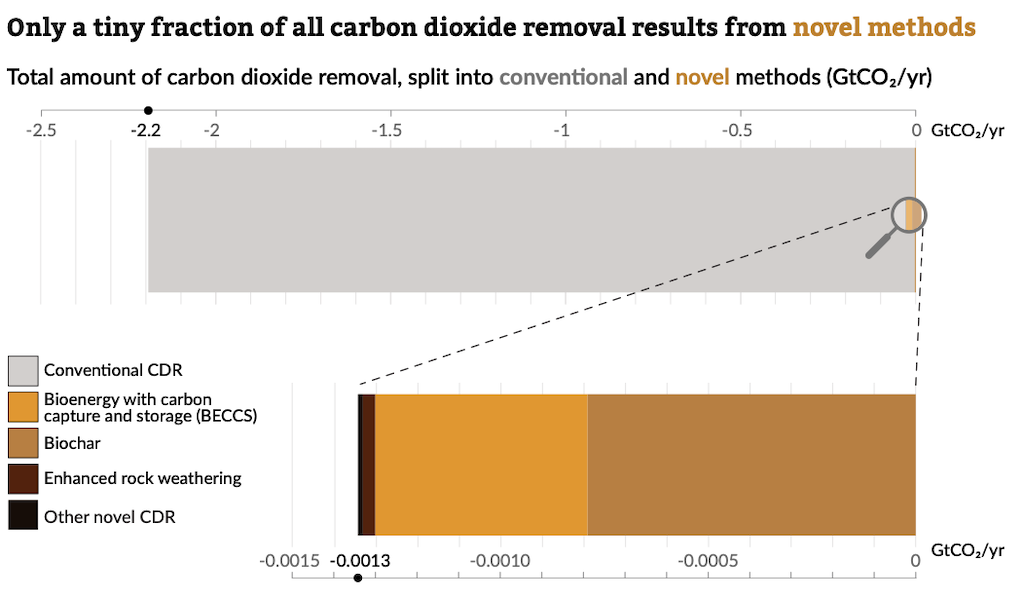
No matter making up the smallest proportion of CDR, “novel” strategies are rising earlier than “typical” methods, with regards to tonnes of CO2 eradicated yearly.
“Novel” CDR eradicated 660,000 tonnes of CO2 in 2021 and 1.35m tonnes of CO2 in 2023, the report says.
Nonetheless, the estimate for “novel” CDR in 2023 is smaller than it was projected to be throughout the first model of the state of CDR report.
That is due to “improved estimation methods” throughout the new state of the native climate report, which are in alignment with the methods utilized by the Worldwide Carbon Value vary, the authors say.
The report says that worldwide areas with the most effective ranges of CDR by way of tree-planting and forest restoration are China, the US, Brazil and Russia. If the EU27 had been a country, it will likely be the first or second largest nation for tree-planting.
Based on accessible data, the nation with crucial contribution to novel CDR is the US, as a result of it hosts all the BECCS vegetation that are in the intervening time in operation, the report supplies.
Once more to prime
The report identifies a model new subset of future conditions that take sustainable enchancment into consideration
Under the Paris Settlement, worldwide areas agreed to limit world warming to successfully below 2C above pre-industrial ranges, with an ambition of sustaining them at 1.5C.
Scientists have devised a wide range of doable conditions for the best way the world may protect temperatures at 1.5C. All of these conditions operate a point of CDR, the report notes.
The report says that, although the Paris Settlement states that native climate movement need to be carried out “throughout the context of sustainable enchancment”, most conditions do not explicitly ponder social and environmental sustainability.
For the first time this 12 months, the report acknowledged a subset of conditions that might probably be thought-about “additional sustainable”.
The authors thought-about a state of affairs to be “sustainable” if it involved:
- Halting deforestation and ecosystem degradation, along with defending biodiversity.
- Decreasing the number of of us at risk from hunger.
- Limiting the growth of worldwide vitality demand, whereas enhancing equitable entry to vitality.
- Limiting reliance on vitality from biomass, to chop again pressure on land and water.
- Retaining temperature rise successfully below 2C, striving to limit it to 1.5C.
All through this group of “sustainable” 1.5C conditions, a central fluctuate of 7-9bn tonnes of CO2 will needs to be eradicated yearly by 2050, the report says.
It supplies that “sustainable” conditions “deploy a lot much less cumulative CDR and much a lot much less novel CDR than totally different mitigation conditions”.
The chart below reveals the amount of CO2 eradicated yearly between 2020 and 2050 beneath a wide range of 1.5C-consistent conditions.
It highlights three “focus conditions” for meeting 1.5C in a “sustainable method”. This consists of 1 centered on vitality demand low cost, one on boosting renewable expertise and one on growing typical and novel CDR.
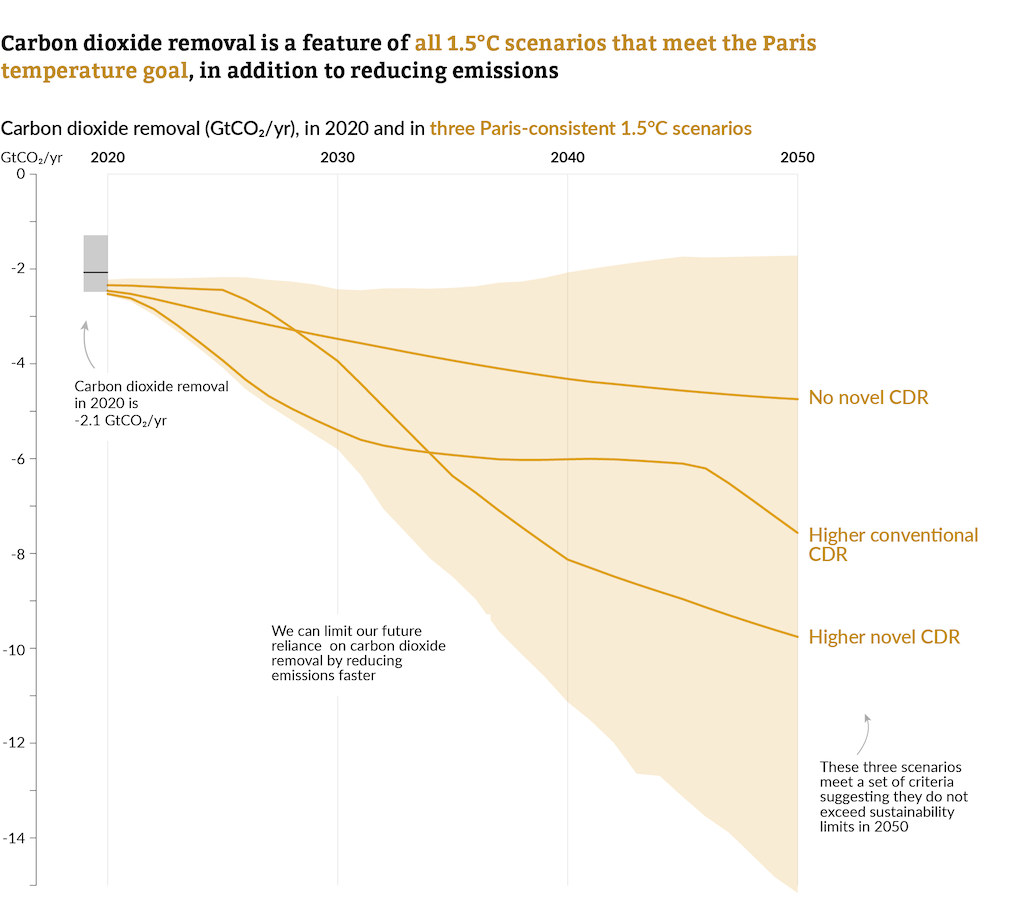
Once more to prime
There continues to be a CDR ‘gap’ to the Paris temperature goal
The report says that there is nonetheless a “gap” between the amount of CDR included in 1.5C-consistent pathways and the amount pledged by worldwide areas of their nationwide native climate plans, typically often called “nationally determined contributions” (NDCs), and long-term strategies.
As compared with the ultimate model, this report considers a wider fluctuate of nationwide pledges on CDR, along with pledges made up until the COP28 native climate summit in Dubai in 2023.
The charts below illustrate the dimensions of the CDR gap in 2030 and 2050, by displaying the extent of proposed CDR (light grey) and the extent wished in quite a few 1.5C-consistent pathways (yellow).
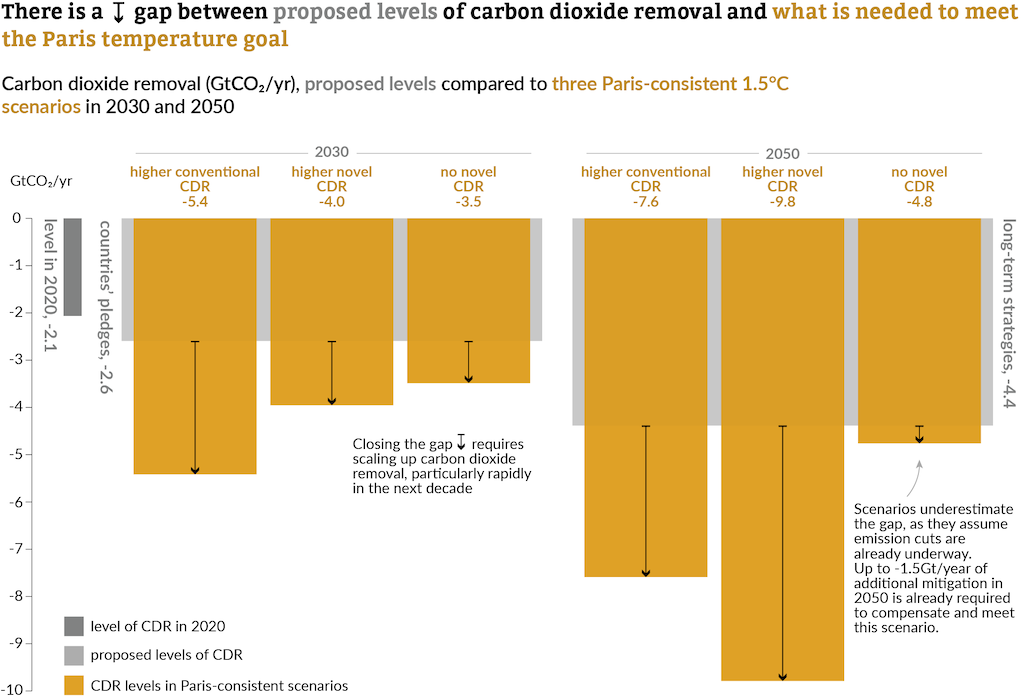
It illustrates that the dimensions of the CDR gap is set by how quite a bit CDR is used to attain 1.5C. (This was the subject of a present evaluation paper lined by Carbon Transient.)
The CDR gap is small when basically essentially the most daring nationwide proposals are in distinction with ranges throughout the “1.5C with no novel CDR state of affairs”, the report says.
Out of three conditions confirmed on the chart above, the CDR gap ranges in dimension between 900m tonnes and a pair of.8bn tonnes of CO2 per 12 months in 2030 and 400m tonnes and 5.4bn tonnes per 12 months in 2050.
The report supplies that, compared with its private estimates, the “exact gap might be going bigger”. It’s as a result of “conditions assume that very important emission reductions are already happening, when truly world emissions have continued to rise”.
Once more to prime
Innovation is usually intensifying, nonetheless with some present slowdowns
The report makes use of quite a few “indicators of innovation” to level out that CDR train is “usually intensifying, although with some present slowdowns”.
The report components to the continued speedy growth in revealed scientific evaluation on CDR, along with the launch of “foremost” demonstration programmes.
These embrace the Regional Direct Air Seize Hubs throughout the US – which have been allotted $3.5bn in funding by way of president Joe Biden’s Bipartisan Infrastructure Laws – and Mission Innovation, a world initiative that encompasses a goal to “enable CDR utilized sciences to comprehend an internet low cost of 100m metric tonnes of CO2 per 12 months globally by 2030”.
The report notes that although new CDR patents “expert speedy growth between 2000 and 2010”, they’ve since started to say no. Nonetheless, it supplies, patents “have flip into additional quite a few and novel methods play a much bigger operate”.
The decide below summarises these findings, displaying the altering counts of research grants, publications and improvements (correct), along with the reduce up between utterly totally different areas (left) and CDR methods (middle).
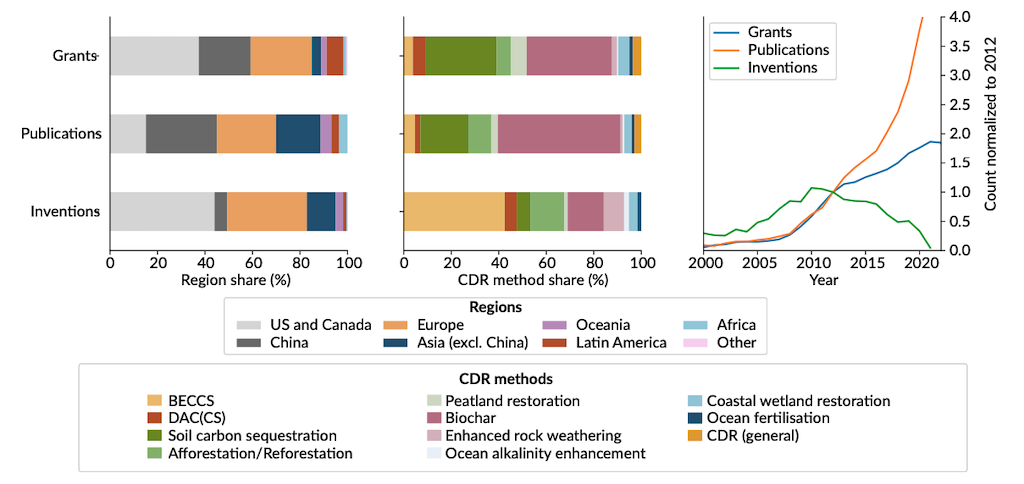
There is a equally blended bag of progress in numerous indicators. As an example, on CDR startup companies, the report says:
“Funding in CDR startups has grown significantly over the earlier decade, outpacing the climate-tech sector as a whole – although it declined in 2023, and CDR accounts for merely 1.1% of funding in climate-tech start-ups.”
The report notes that direct air carbon seize and storage (DACCS) has “flip right into a foremost focus for firm and totally different large consumers in CDR”, together with:
“Foremost CDR startups akin to Climeworks and Carbon Engineering have acquired investments from firms that have to offset emissions from their core enterprise (e.g. Microsoft, Airbus, Chevron, JP Morgan).”
The report moreover concludes that CDR companies and enterprise groups have launched functionality targets that “current ambition to attain, by mid-century or sooner, ranges of CDR per meeting the Paris temperature goal”. Nonetheless, it supplies, they’ve “little grounds for credibility at present”.
Once more to prime
There was ‘common growth’ in CDR evaluation grants
The report consists of – for the first time – analysis of research grants which had been awarded for CDR as one amongst its indicators of innovation.
This analysis makes use of the Dimensions database of research initiatives granted by third-party funding our our bodies, which contains the number of initiatives and – in about three-quarters of cases – the amount of funding.
Between 1991 and 2022, the analysis identifies grants from 131 funding organisations, akin to evaluation councils, foundations and philanthropic groups. (The data solely covers specific grants, not funding coming by way of an institution’s central worth vary.) These grants went to spherical 1,600 evaluation organisations and full spherical $2.6bn, the report estimates.
As a result of the chart below illustrates, every the quantity (yellow bars) and value (grey) of grants have “grown steadily” these days. The report says:
“The number of evaluation grants for CDR has grown from 35 vigorous grants all through 2000 to 1,160 all through 2022…About 74% of all evaluation grants on CDR throughout the data set started all through the ultimate 10 years (2013-22).”
The annual price of grants has grown from about $5m in 2000 to about $190m in 2022, the report supplies.
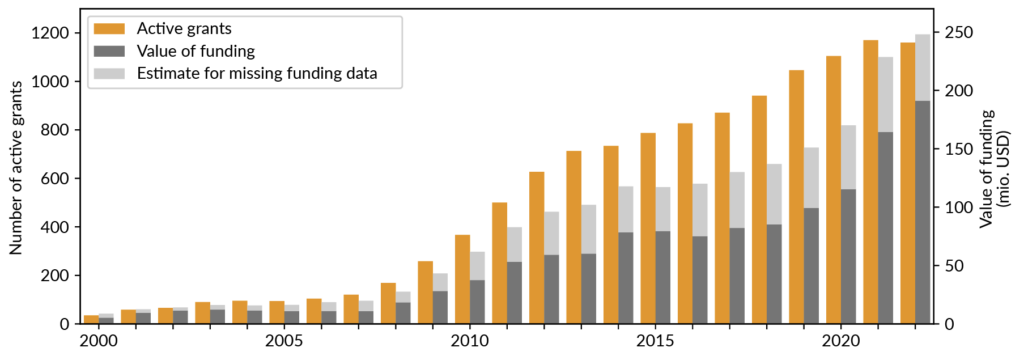
Practically 70% of all vigorous CDR evaluation grants over 2000-22 consider soil carbon sequestration (35%) or biochar (33%), the report says. Although, as a result of the chart below reveals, grants “have been diversifying over time”, with an rising share for various methods by 2022, akin to DACCS (11%), peatland restoration (8%), coastal wetland restoration (7%), enhanced rock weathering (5%) and BECCS (5%).
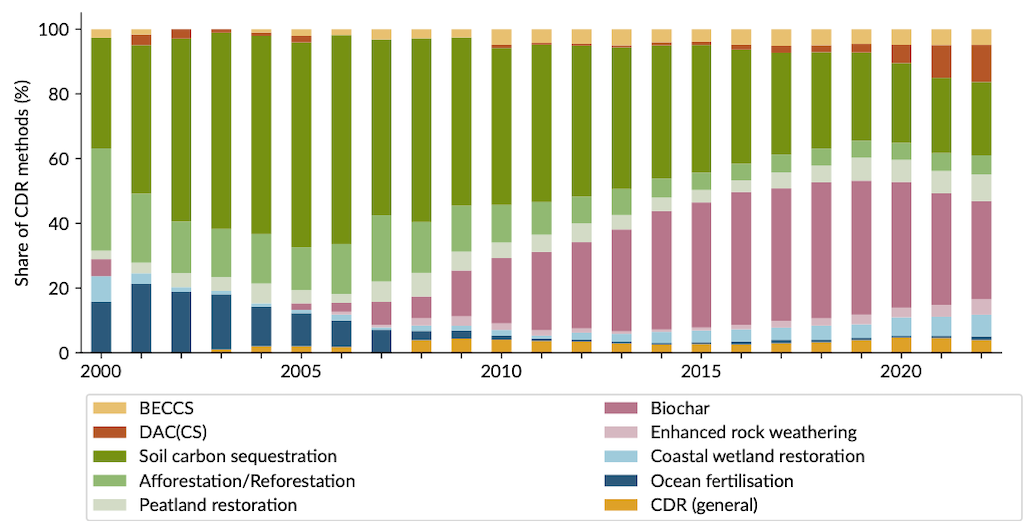
The overwhelming majority of research funding is in Canada and the US, the report says. The two worldwide areas account for 40% of all vigorous evaluation grants between 2000 and 2022 and 59% of the funding.
The 27 worldwide areas of the EU collectively account for spherical 19% of CDR funding, the report says, whereas merely three non-EU worldwide areas – Norway, Switzerland and the UK – collectively account for 11%. Within the meantime, it supplies, China “funds many CDR initiatives, nonetheless the financial help reported is comparatively small”.
Once more to prime
On social media, the consider utterly totally different CDR methods has modified over the earlier 12 years
The second model of the report consists of an exchange to its analysis of how CDR is talked about on Twitter. This consists of extending its dataset to the highest of 2022 and together with “new data on client kinds and posting frequency”.
In full, the dataset covers 570,000 English-language tweets over 2020-22 (and does not embrace retweets). The authors used machine learning to classify whether or not or not the tone of the tweets had been constructive, unfavorable or neutral.
Common, the report finds that the amount of consideration that CDR acquired from English-speaking Twitter accounts in 2022 was similar to 2021, nonetheless “with usually additional constructive sentiment within the course of acquainted and conventional CDR methods than to totally different methods”.
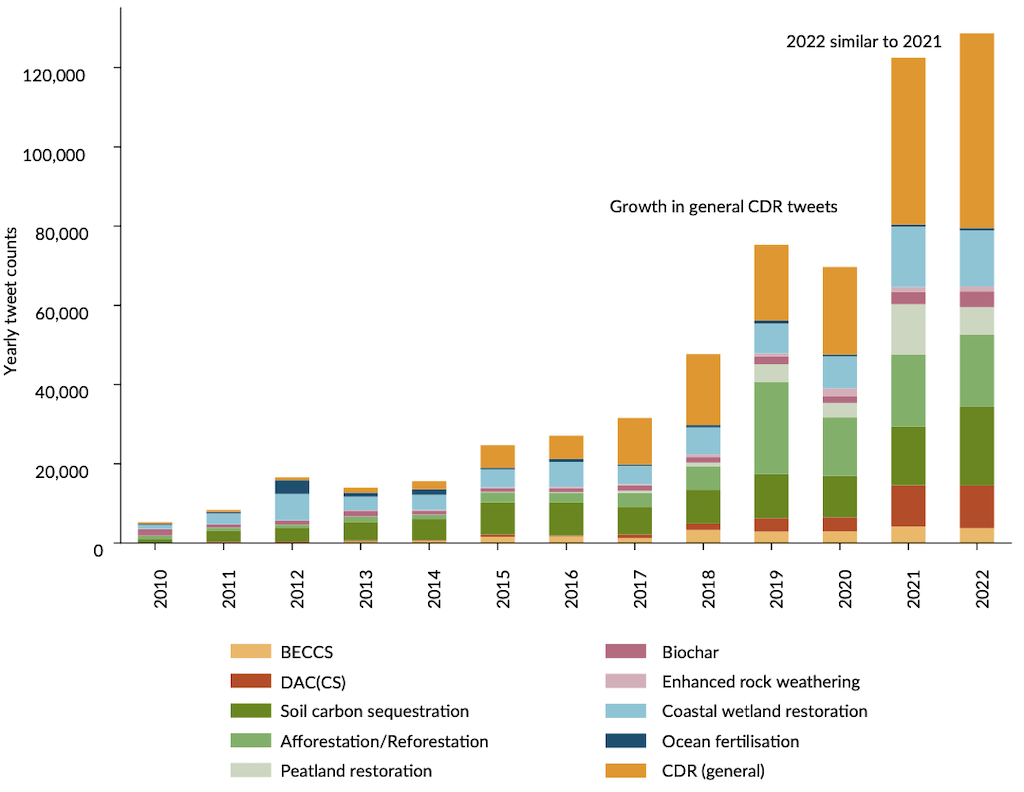
Making an attempt all through the whole time interval, the authors uncover that “earlier tweets primarily centered on specific CDR methods, akin to soil carbon sequestration, coastal wetland restoration, ocean fertilisation, afforestation and biochar”. They add that “present years have seen an increase throughout the share of tweets about CDR on the entire, along with an enlargement to novel CDR methods akin to DACCS and BECCS”.
The analysis moreover finds that CDR tweets have flip into additional constructive over time. As an example, “tweets on natural seize methods have a constructive sentiment way more usually than a unfavorable sentiment, aligning with the survey literature on perceptions”, the report says.
The overwhelming majority of tweets (70%) come from clients in Australia, Canada, the UK and the US, the report finds, however moreover from these in Belgium, Chile, France, Germany, Ghana, India, Norway and Switzerland. The report notes that “sentiments are usually additional unfavorable in Australia, Canada and Germany than in India, the UK and the US”.
The authors moreover uncover variations by way of which CDR methods are being tweeted about. They write:
“As an example, clients from Australia, India and the US submit additional about soil carbon sequestration than others. UK clients submit additional about peatland restoration and coastal wetland restoration, whereas Ghanian clients consider biochar and regular CDR.”
Once more to prime
Media safety of CDR tends to peak spherical COPs
The report consists of recent analysis of how CDR has been reported in English-speaking media across the globe over the earlier three a very long time.
The chart below illustrates how CDR reporting has elevated since 1990. The analysis of higher than 9,000 articles reveals that the “important interval of media reporting” started in 2007.
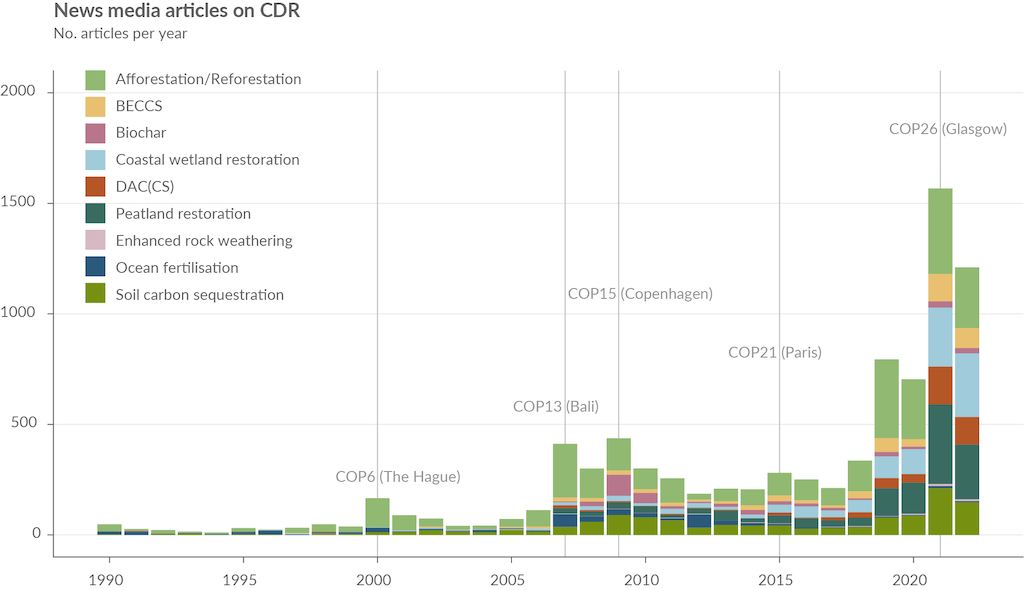
The authors set up a “foremost enhance” in CDR info safety from 2019, peaking throughout the run as a lot because the COP26 native climate summit in Glasgow in 2021 as worldwide areas updated their Paris Settlement pledges. They write:
“Since lots of these targets included net-zero pledges, the following native climate protection discourse tended to operate CDR prominently.”
For lots of the three-decade interval, peaks in CDR reporting have coincided with native climate summits, the report supplies, along with “COP13 in Bali in 2007, the place a lot of worldwide forestry initiatives had been launched; and COP6 in The Hague in 2000, the place the operate of forests as carbon sinks first sparked very important debate beneath the UNFCCC course of”.
Mentions of CDR throughout the info are “comparatively concentrated specifically info media and worldwide areas”, the report notes. As a result of the upper chart below reveals, Australian and UK press dominate safety, accounting for eight of the very best 10 sources for a lot of articles.
The lower chart reveals a breakdown of which CDR methods are inclined to operate in info articles for specific particular person worldwide areas. Soil carbon sequestration choices intently in Australia, the authors discover, “reflecting its bigger state of integration into Australian native climate protection”.
Elsewhere, peatland restoration is “additional excellent throughout the Irish and UK press”, the report says, whereas afforestation and coastal wetland restoration have greater shares in India and Pakistan.
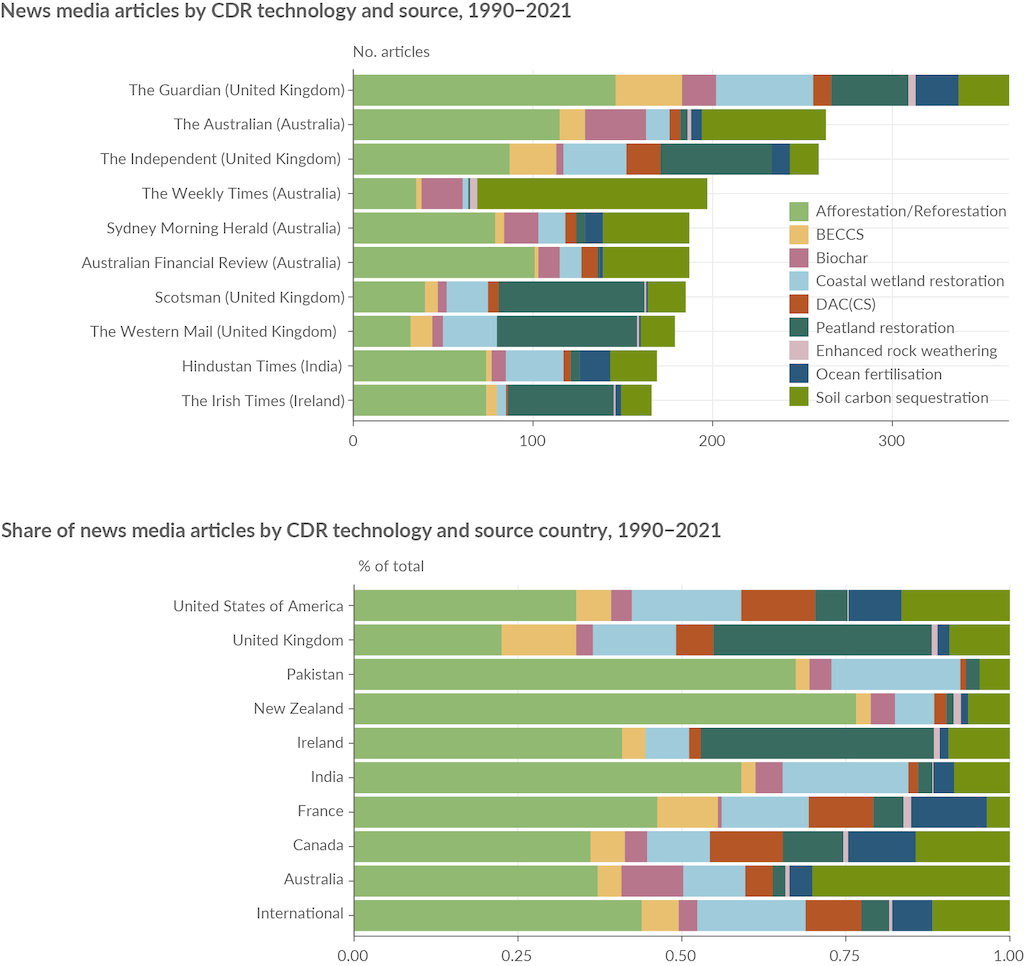
Further analysis of a random sample of 1,500 info articles implies that CDR reporting tends to “intersect with totally different concepts and mitigation approaches, along with (fossil-based) carbon seize and storage [CCS], carbon seize and utilisation [CCU] (e.g. synthetic gasoline manufacturing, biofuels) and prevented emissions (e.g. forest carbon offsets)”.
The authors add:
“Journalists do not basically distinguish between these utterly totally different lessons of mitigation, however it is vitally necessary discuss the exact operate of CDR as distinct from emission low cost efforts.”
Once more to prime
Insurance coverage insurance policies are wished that create demand for carbon removals
The report says that, to have the ability to enhance CDR innovation and scale-up, “insurance coverage insurance policies
are wished that create demand for carbon removals”.
It says that “CDR protection gained momentum in 2023”. It observed “vigorous efforts” in a number of worldwide areas for “know-how push insurance coverage insurance policies”, along with evaluation initiatives and demonstration schemes.
Nonetheless, it says that “demand-pull insurance coverage insurance policies”, these geared towards creating demand for CDR, “keep weak”.
NDCs comprise “few mentions of insurance coverage insurance policies which may create a serious demand for CDR”, it says, and “monitoring, reporting and verification (MRV), which is important for facilitating transactions in CDR markets, should not be completely developed at present”.
When compared with movement from policymakers, the voluntary carbon market is “having fun with a key operate in scaling up CDR”, the report says.
The voluntary carbon market is a spot the place polluting firms can buy credit score from carbon-cutting initiatives, allowing the businesses to say they decreased their very personal emissions. It has been quite a bit criticised by researchers for failing to remain as a lot as ensures to cut emissions.
Carbon Transient analysis reveals that merely 3% of carbon credit score available on the market on the 4 largest voluntary offset registries are for CDR initiatives, with the remaining being for “prevented emissions” initiatives.
The first model of the state of CDR report consists of case analysis for CDR insurance coverage insurance policies in Brazil, EU, US and UK. The second model consists of recent case analysis for Canada, China, Japan and Saudi Arabia.
Once more to prime
Monitoring, reporting and verification is ‘necessary’ for scaling up CDR, nonetheless there are dozens of assorted protocols
The report notes that monitoring, reporting and verification (MRV) for CDR is “necessary” for guaranteeing that CO2 has been captured from the ambiance and saved durably. The report defines MRV as the strategy of:
- Measuring or quantifying CO2 removals from a CDR train and monitoring these CO2 removals over the course of a CDR train.
- Reporting on these removals.
- Receiving third-party verification of the removals which had been reported.
Approaches to MRV are described in “protocols”, which the report defines as any doc that outlines methods or items prime quality requirements or suggestions for certification.
Sturdy MRV is “important” for “environment friendly voluntary carbon markets, government-created markets, legal guidelines and nationwide reporting”, the authors say. Nonetheless, in the interim, there are “many overlapping protocols, which makes comparability and oversight of CDR troublesome for consumers and governments alike”.
The report identifies 102 MRV protocols for CDR, which are confirmed throughout the chart below in accordance with the 12 months by way of which that they had been developed.
The authors discover that 63% are for typical CDR, 65% are for voluntary markets and 58% are for worldwide actions. Some 40% have been developed since 2022.
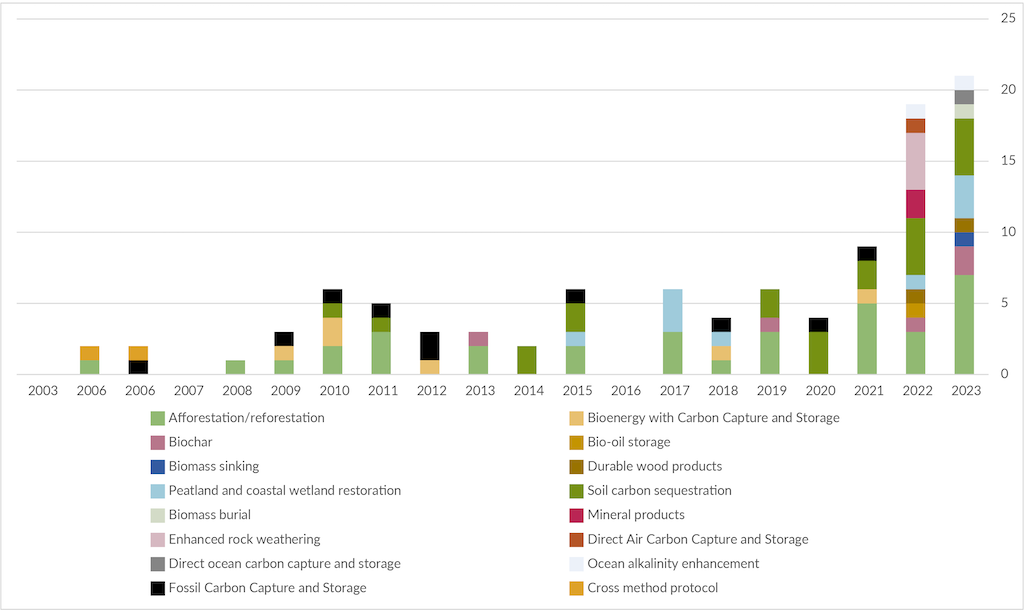
Internationally, “Europe (along with the UK) accounts for 44% of full MRV protocol enchancment, North America makes up 42%, Oceania 5%, Asia 4%, Latin America 3% and Africa 2%”, the report says.
MRV policymaking differs all through these jurisdictions, it notes:
“As an example, the EU and the UK have prioritised rising CDR necessities and suggestions; the US, within the meantime, has centered on scaling up market-ready CDR and rising MRV devices for specific functions, akin to marine CDR. The voluntary carbon market has carried out a primary operate, with initiatives rising methods for monitoring, reporting and verifying CDR initiatives.”
In addition to, there are utterly totally different MRV challenges for each CDR method, the authors say:
“For novel CDR, additional evaluation is required to develop and try MRV know-how, along with at large-scale demonstration web sites.”
One downside for novel CDR methods, akin to DACCS, is that they usually use proprietary strategies that are not publicly accessible. Their MRV protocols are, subsequently, “inaccessible”, the authors say, and so it isn’t doable to match them with these that are public.
For typical CDR, “questions persist” spherical designing versatile MRV approaches which will accommodate utterly totally different contexts, scales and approaches, the report says.
Whereas the authors describe the current lack of IPCC greenhouse gasoline guidance methodologies for a lot of novel CDR methods as a “foremost gap”, they discover that the deliberate IPCC methodology report on CDR, CCS and CCU “is predicted to stipulate a framework for along with novel CDR methods in nationwide inventories”.
This framework “will likely info best observe throughout the voluntary carbon market and the occasion of nationwide insurance coverage insurance policies”, the analysis says.
Sharelines from this story
